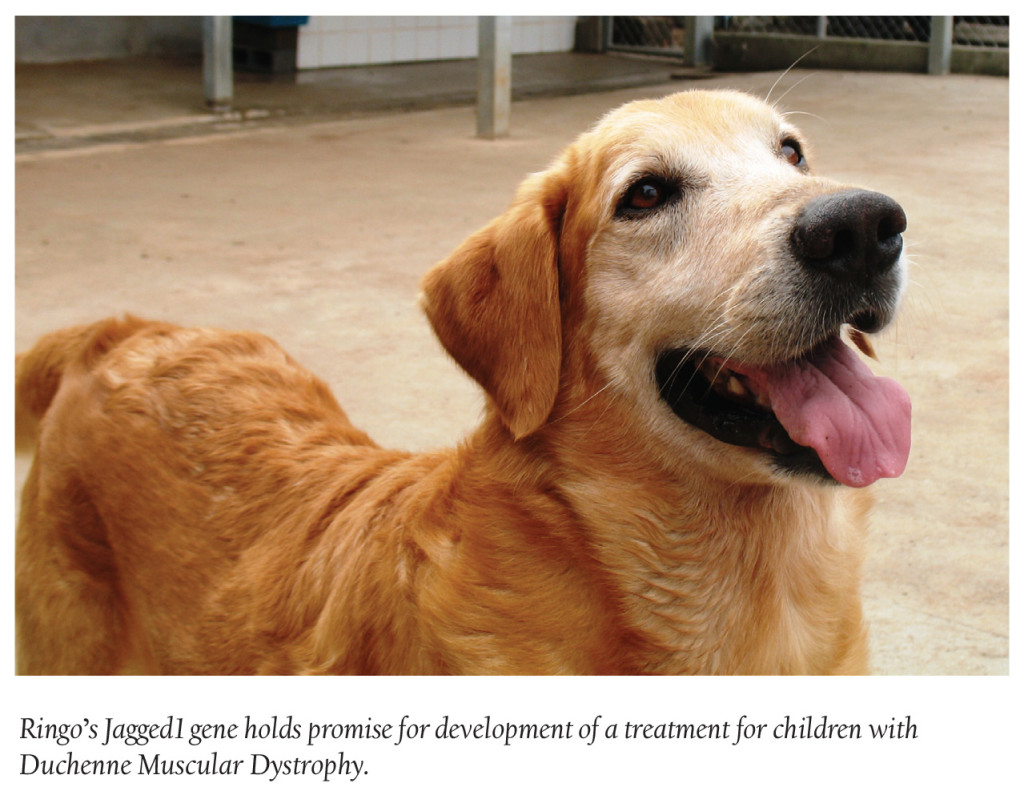Discoveries/Innovations: Ringo May Help Scientists Treat DMD
Scientists are on track toward development of a treatment for the muscle-wasting disorder Duchenne Muscular Dystrophy (DMD) thanks to the contribution of Ringo, a golden retriever who lived a healthy life despite having the disease. Why? According to the journal, Cell, it was discovered that Ringo possessed a gene that stimulates muscle regeneration—and scientists from Boston Children’s Hospital, the Broad Institute of MIT, Harvard, and Brazil’s University of São Paolo hope to harness the gene to treat this common form of muscular dystrophy in children.
Unlike his siblings who also had DMD, Ringo was able to run normally and lived to the age of 11. The only gene that functioned differently in Ringo, called Jagged1, a component in muscle regeneration, was located on the 24th chromosome that causes the disorder. After further studies, scientists are convinced it is involved in overcoming DMD and can provide a promising avenue of therapy for children.
Trend Setting: Vocal Cord Cloning May Grant the Power of Speech
A condition known as dysphonia robs many individuals of the most important tool needed to communicate: A voice. Dysphonia is a condition that makes speaking extremely difficult due to either a lack of vocal cord tissue or tissue damage. But scientists made a huge advancement toward overcoming this disorder using two types of vocal cord cells to generate a scaffolded mucosa that allows sound to vibrate from the vocal cords when warm, moist air passes through. Implanted into dog larynxes, they found it created a nearly natural sound when air passed through. It was then grafted into humanized mice, where humanized cells took to the scaffolding—providing hope that a bioengineered vocal fold mucosa can restore a patient’s voice.
Med Device: Bomb Detector Could Also Locate Tumors
When Stanford engineers planned to build a device to detect buried plastic bombs, they also got the idea that it could help to detect tumor growth in humans.
How? Different substances absorb heat energy and transmit different ultrasound waves. Since tumors grow additional blood vessels to support their rampant growth, the engineers noted that they absorb more heat energy and send a distinct ultrasound signal.
The new devices could be sufficiently sensitive to scan the body from a few feet away and detect their location. Led by Assistant Professor Amin Arbabian and Research Professor Pierre Khuri-Yakub at Stanford, they note that the device could be cheaper than other imaging tests and completed within five to 15 years. Both note that the device is a handheld portable and the procedure is non-intrusive.
Doctor Docs: Ultra-realistic Child Anatomy Models Train Surgeons
Realistic models of children’s anatomy that can better prepare surgeons for various medical operations have been developed through a collaboration between special effects company, Fractured FX, and the Boston Children’s Hospital’s simulator program, SIMPeds. The models both look—and feel—real. In fact, the artificial tissues bleed, pulsate and feel like the real organs. SIMPeds Director Peter Weinstock, MD, PhD thinks this is a major development, noting, “To make simulations effective, you want to promote suspension of disbelief, to create an environment in which everyone believes they’re working on a real child.”
One model of a child’s head guides trainees through complex brain surgeries. Another guides surgeons through a heart-bypass operation. Interestingly enough, Dr. Weinstock approached Fractured FX (which won an Emmy for American Horror Story: Freak Show) because their work on the Cinemax series, The Knick, created very realistic hospital scenery.
Patient Pages: Videos Aid Patients with Pancreatic Cancer
Roughly 35,000 patients are diagnosed with pancreatic cancer annually, and the numbers are growing—and signs and symptoms are often not noticed until after the cancer has spread. To help patients and their caregivers in disease management, CURE Media Group created Cure Connections, a series of 10-minute videos aimed at teaching those affected how to cope with the disease; be a partner to a diagnosed patient; offer treatment options and tips from cancer patients; address staying positive while delivering bad news; learn about current R&D developments and the side effects of chemotherapy; and provide information on blood tests, biopsies and symptoms.
Videos feature patients and family members and renowned oncologists and directors from Georgetown University Hospital and the Georgetown Lombardi Comprehensive Cancer Center who offer their respective views on pancreatic cancer and care. Videos are available at www.curetoday.com.
FDA Update
FDA Launches precisionFDA Portal
precisionFDA is a new, recently launched cloud-based platform designed to foster collaboration among scientists to create further innovation in Next-Generation Sequencing (or NGS). NGS offers scientists the ability to diagnose, treat or cure each individual based on their genes—creating a truly personalized treatment for numerous diseases. The precisionFDA portal can be accessed by code on the world’s largest open software repository, GitHub, at which numerous tools to aid discovery can be found.
Drug Approvals
Eli Lilly’s Basaglar (insulin glargine injection) received FDA approval to treat children and adults with type 1 diabetes and adults with type 2 diabetes. Basaglar is a long-acting human insulin and is the first insulin product approved through an abbreviated FDA 505(b) (2) regulatory pathway.
Uptravi, a treatment for pulmonary hypertension manufactured by Actelion, received FDA approval. The new treatment is an oral, selective prostacyclin receptor agonist that delays the disease’s progression and can thereby reduce the risk for patient hospitalization.
Merck’s Keytruda received expanded indication approval to include first-line treatment of patients with unresectable or metastatic melanoma. The treatment is the first anti-PDI cleared for previously untreated advanced melanoma in patients with or without the BRAF mutations.
Med Device Approvals
A wearable cardioverter defibrillator, ZOLL Medical’s LifeVest, received expanded indication FDA approval as a treatment for sudden cardiac arrest in children who cannot receive an implantable defibrillator. The LifeVest is indicated for children weighing at least 41 pounds with a chest size of 26 inches.





